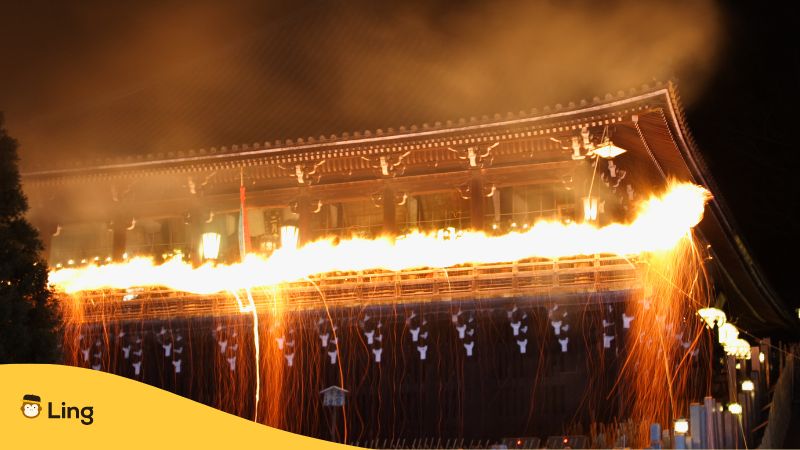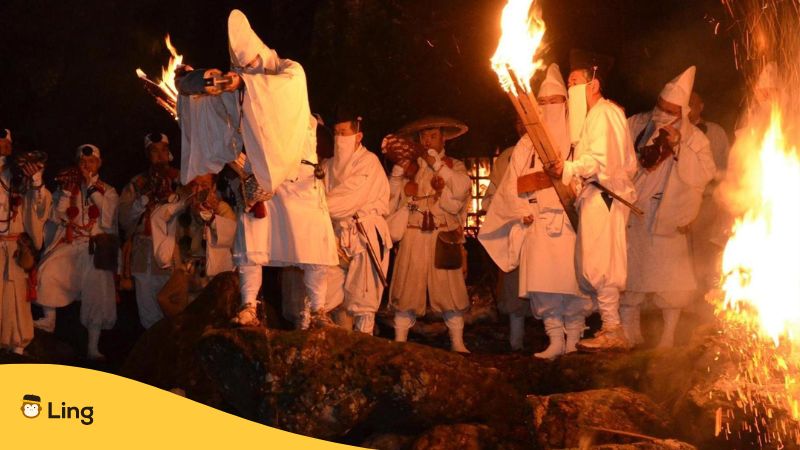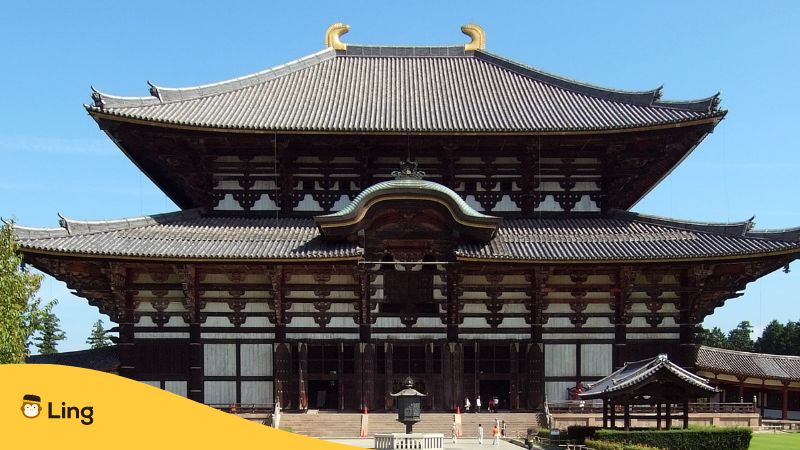When you think about spring season in Japan, cherry blossoms, or sakura (桜), are probably the first thing that comes to mind. But did you know that it isn’t the only thing to look forward to in March?
Enter Omizutori Festival (お水取り). お (o) is an honorific prefix used to show politeness, as in “Okyakusama” (お客様), which means “customer,” or “Otanjōbi” (お誕生日), which means “birthday.” 水 (mizu) means “water,” while 取り (tori) means “to fetch.” Put together, Omizutori literally means “water fetching”! That’s why it’s known as the sacred water drawing ceremony.
In this guide, I’ll be telling you all there is to know about the Omizutori ceremony. And while I’m at it, I’ll be teaching you some easy Japanese phrases that you can use should you decide to visit.

What Is The Omizutori Festival?
If I were to sum up the festival in four words, it’d be: goodbye winter, hello spring! Held for two weeks from March 1st to the 14th in Nara (奈良), which is one of the oldest Japanese cities, this 1200-year-old Buddhist celebration is all about ushering in the spring season.
It’s also known as the Shuni e ceremony (修二会), which literally means “second-month service.” You may be wondering, isn’t March the third month of the year? You’re not wrong, but you should know that it’s also the second month of the old lunar calendar!
There are many famous temples in Japan, but this particular series of repentance rituals takes place at one particular temple. It’s held in the grand Nigatsudo Hall (二月堂) in the Todaiji Temple (東大寺) complex. By the way, Nigatsudo Hall means “the hall of the second month,” which corresponds with Shuni e, which similarly means second-month service!

How To Celebrate Omizutori Festival
Enjoy A Festival Of Fire And Water
Now that you’re more familiar with what the event’s all about, let’s talk more about the ceremonies, which involve water drawing and a ritual. But first things first; despite its name, did you know that water isn’t the only element involved in this event?
It goes without saying that the Otaimatsu Ceremony (お松明) is the main attraction. When the night falls, monks known as the Renkyōshu (蓮教主) light and carry giant torches up to the balcony of Nigatsudo Hall. There are usually around ten monks who will take turns to hold the lit torches. The sparks of their blazing torches rain down on the crowd below. It’s believed that by standing below the temple and letting the torches’ sparks touch you, you’ll be purified and blessed with a safe year ahead.
This fiery spectacle takes place every night of the event. It’s only from March 12th to 13th when things change up a bit! Instead of fire, water is the star of the show. Sacred water is drawn from the Wakasa Well (若狭井) over Nigatsudo. It is believed that this water flows only once a year and is infused with the blessings of Kannon (観音), the Goddess of Mercy. This water is also said to have restorative powers and healing properties that will benefit one’s well-being. That’s why it’s offered as scented water to deities, and why everyone wants to draw water from the well on this day!
After this ceremony, the Dattan ceremony takes place in the hall. It’s a rather mysterious and intriguing ritual since everything happens inside. If you’re standing outside, you’ll hear the blowing of horns, the ringing of bells, and the rapid swinging of burning torches by monks. This goes on until around 3am. Not your typical morning routine!
Otaimatsu, which means “torches” or “flames”, represents the fire, while Omizutori represents the water. That’s why the celebration is also known as a Festival of Fire and Water!
Take A Walk At Nara Park
If you have friends who’ve been to Osaka (大阪市), you may’ve seen them feeding cute deers, called Shika (鹿) in Japanese, or maybe even being playfully chased by them! No matter how many people feed them, those adorable deers always seem to be hungry!
And if you’ve always wanted to visit, you’re in luck because you can find them at Nara Park (奈良公園), which is just a stone’s throw away from the temple and Kintetsu Nara Station (近鉄奈良駅) or JR Nara Station (奈良駅). You can choose to visit after the previous ceremonies and prayers, or before getting cleansed and renewed at the area.
Having existed since 1880, this park is one of the oldest in Japan. In addition to the deers and Todaiji Temple, it’s also home to iconic attractions like Kasuga Grand Shrine (春日大社) and Nara National Museum (奈良国立博物館). So, if you have time to spare before or after the event, don’t forget to check out Nara Park, too!

Easy Japanese Phrases For Omizutori Festival
Now that you’ve learned about the festival, here are some useful Japanese words and phrases that you can use, just in case you’re hoping for a few of the monks’ sparks to fall on and bless you with good fortune for the year ahead.
| English Translation | Japanese Script | Romanization |
|---|---|---|
| Kintetsu Nara Station | 近鉄奈良駅 | Kintetsu Nara eki |
| Second month service | 修二会 | Shuni e |
| Ceremony/Rituals | 儀式 | Gishiki |
| God | 神 | Kami |
| Night | 夜 | Yoru |
| I want to go to the Omizutori festival. | お水取り祭りに行きたいです。 | O mizutori matsuri ni ikitai desu. |
| It’s a wonderful festival, isn’t it? | 素晴らしい祭りですね。 | Subarashii matsuri desu ne. |
| What does this festival celebrate? | この祭りは何を祝っていますか? | Kono matsuri wa nani o iwatteimasu ka? |
| Is the festival food delicious? | お祭りの食べ物はおいしいですか? | O matsuri no tabemono wa oishii desu ka? |
| The atmosphere of the festival is great, isn’t it? | 祭りの雰囲気が楽しいですね。 | Matsuri no funiki ga tanoshii desu ne. |
Ready To Experience The Omizutori Festival?
That’s it! If you’re planning a trip to Japan in March, I hope this article convinced you to check out something besides your usual cherry blossoms. I also hope the simple Japanese words and phrases made you curious to learn more! That’s why you should check out the Ling app, which offers fun and enjoyable Japanese lessons that’ll definitely be useful for your journey.
So say Konnichiwa (こんにちは) to new experiences by downloading the Ling app and applying what you’ve learned at Omizutori. I doubt you can beat the crowds, but still, be sure to arrive early if you don’t want to miss out! All the best, or should I say, Ganbatte (がんばって), and safe travels!































































